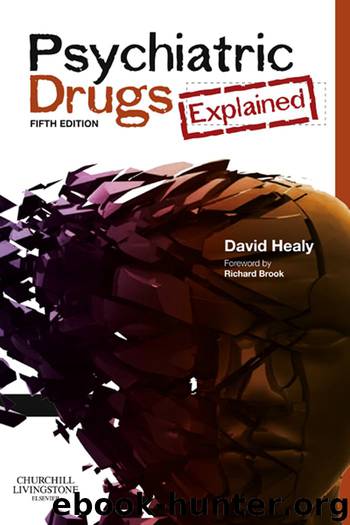Psychiatric Drugs Explained E-Book by David Healy

Author:David Healy
Language: eng
Format: mobi
ISBN: 9780702029974
Publisher: Elsevier Health Sciences
Published: 2008-12-05T02:00:00+00:00
Table 11.1 Serotonergic system drugs
AgonistAntagonist
S1a Buspirone Spiperone
Flesinoxan Propranolol
Gepirone
Ipsapirone
S2a D-LSD Ketanserin
Mianserin
Mirtazapine
Trazodone
Nefazodone
All antipsychotics
S2b mCPP Ritanserin
S2c Mianserin
Mirtazapine
Agomelatonin
SSRIs
The first point to note is that the SSRIs as a group are more clearly anxiolytic than antidepressant. When the SSRIs were launched the marketing imperatives dictated that these drugs were brought on the market as antidepressants rather than tranquillisers or anxiolytics. But it was clear that the companies would seek licences for anxiety states also and this they did during the 1990s. In recent years paroxetine, venlafaxine, sertraline and other SSRIs have been licensed for post-traumatic stress disorder (PTSD), obsessive–compulsive disorder (OCD), generalised anxiety disorder (GAD), social phobia and other anxiety states. What a licence means is not that clinicians are now able to prescribe these drugs for patients who are anxious but rather that companies have the chance to market anxiety, and they have been doing so to the tune of hundreds of millions of dollars per year, especially in the USA. This marketing has come complete with references to the chemical imbalance that is supposedly the cause of GAD or social phobia. What chemical imbalance? – lowered serotonin levels. There are also references to non-habit-forming paroxetine or to the fact that anxiety can be treated with benzodiazepines or SSRIs but the benzodiazepines cause dependence – with the clear implication that SSRIs do not cause dependence. There is in fact every reason to believe that SSRIs cause dependence just as frequently as benzodiazepines and that this dependence syndrome is in fact in many cases far more difficult to recover from than benzodiazepine dependence.
The side effects and interactions of the SSRIs are described in Chapter 5. These are the same for both anxiety and depression. Dependence on SSRIs is dealt with in Chapter 23.
S1 agonists
Buspirone, an S1 agonist, was marketed under the trade name Buspar in the mid-1980s as an anxiolytic. Given the degree of concern there had been about the use of benzodiazepines in the treatment of anxiety, it seemed a safe bet that a non-benzodiazepine anxiolytic, an anxiolytic that did not produce dependence, would sweep the market. Buspirone did not do this.
There seem to be three reasons why not. First, buspirone does not give the same pleasant feeling that the benzodiazepines produce, and consumers accordingly did not ‘go for it’. Another is that it does not work immediately. It takes anything from 2 to 4 weeks for effects to appear, which is not much help in many forms of acute anxiety. Finally, the reaction to claims that it is not dependence-producing were: ‘Oh yes, we’ve heard that one before and look what happened…’.
In the treatment of anxiety, buspirone is used in doses from 5 mg three times a day to 30–60 mg daily. The side effects are those of the SSRIs. The problems are worse if it is combined with other drugs active on the serotonin system, such as the SSRIs, or with antipsychotics. The use of drugs active on the serotonin system in combination with a variety of other psychotropics also may lead to the development of a ‘serotonin syndrome’ (see Ch.
Download
This site does not store any files on its server. We only index and link to content provided by other sites. Please contact the content providers to delete copyright contents if any and email us, we'll remove relevant links or contents immediately.
Life 3.0: Being Human in the Age of Artificial Intelligence by Tegmark Max(5184)
The Sports Rules Book by Human Kinetics(4078)
The Age of Surveillance Capitalism by Shoshana Zuboff(3985)
ACT Math For Dummies by Zegarelli Mark(3851)
Blood, Sweat, and Pixels by Jason Schreier(3492)
Unlabel: Selling You Without Selling Out by Marc Ecko(3470)
Hidden Persuasion: 33 psychological influence techniques in advertising by Marc Andrews & Matthijs van Leeuwen & Rick van Baaren(3292)
Urban Outlaw by Magnus Walker(3242)
The Pixar Touch by David A. Price(3208)
Bad Pharma by Ben Goldacre(3095)
Project Animal Farm: An Accidental Journey into the Secret World of Farming and the Truth About Our Food by Sonia Faruqi(3018)
Brotopia by Emily Chang(2896)
Kitchen confidential by Anthony Bourdain(2824)
Slugfest by Reed Tucker(2802)
The Content Trap by Bharat Anand(2778)
The Airbnb Story by Leigh Gallagher(2700)
Coffee for One by KJ Fallon(2422)
Smuggler's Cove: Exotic Cocktails, Rum, and the Cult of Tiki by Martin Cate & Rebecca Cate(2338)
Beer is proof God loves us by Charles W. Bamforth(2249)
